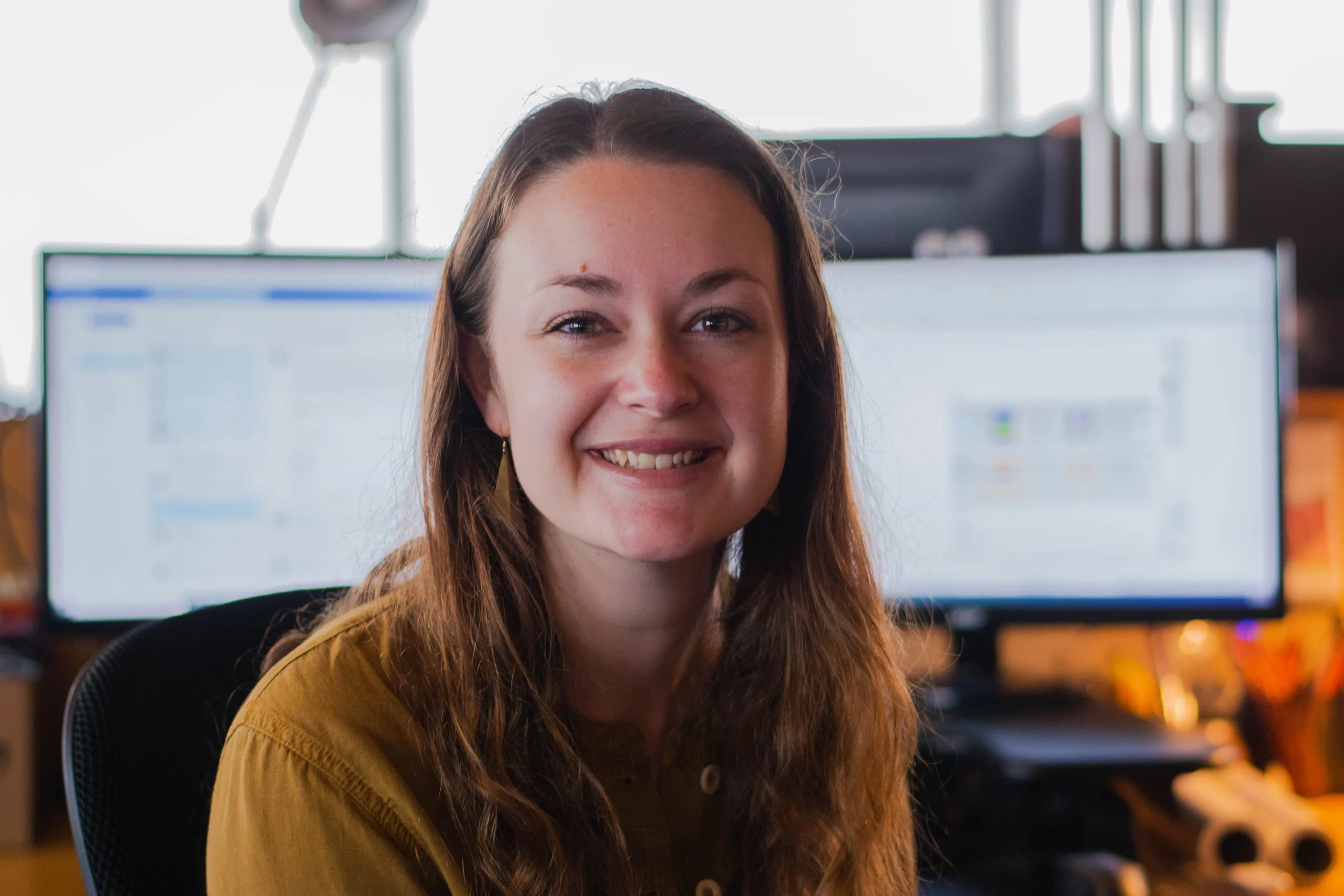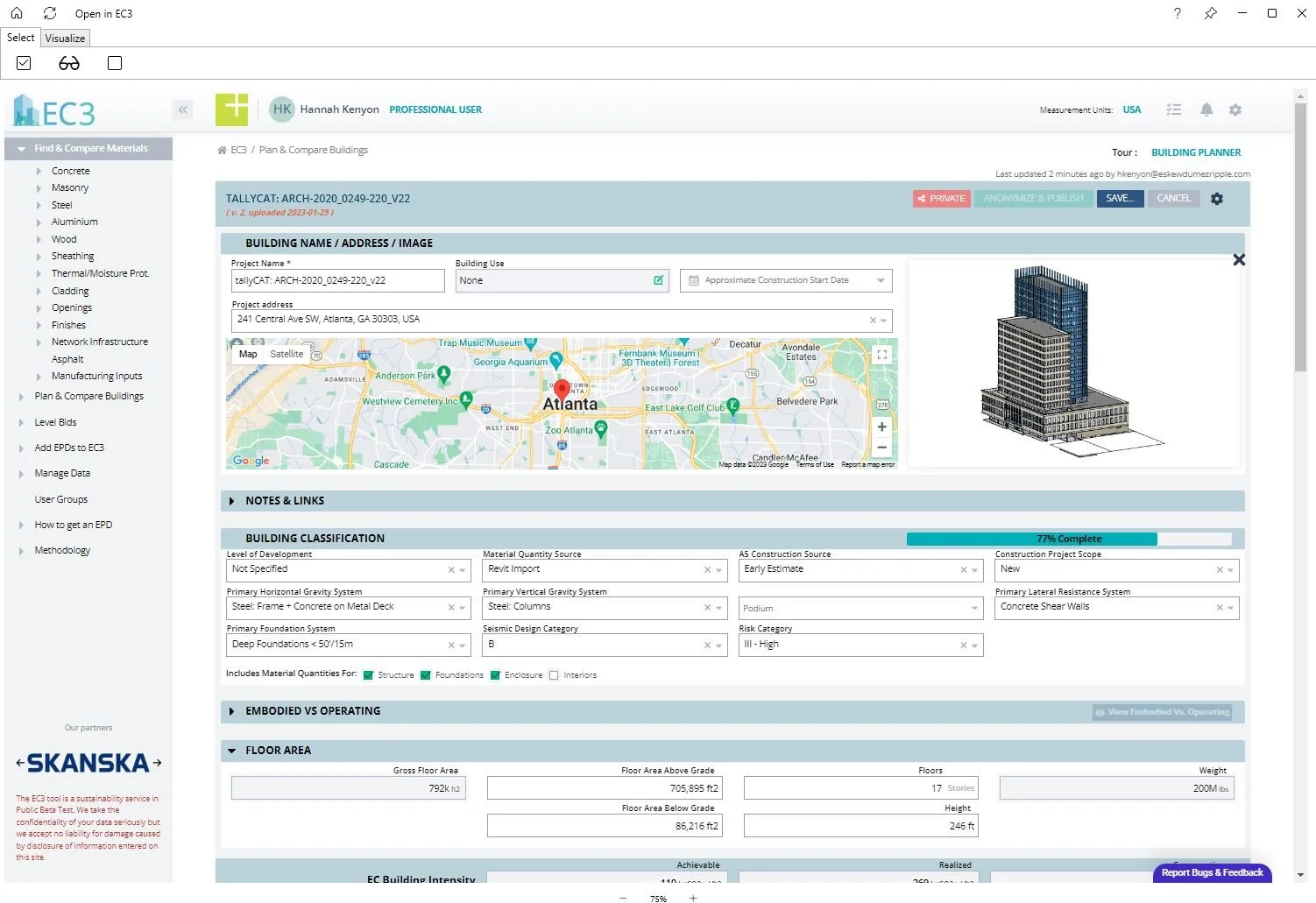Designers at Their Desk: Hannah Kenyon

Designers at Their Desk is a monthly feature showcasing a conversation with one of our staff, their unique outlook on architecture and design, hobbies, interests, and their current projects.
Hannah Kenyon, like most designers of her drive and caliber, is keeping track of a lot. Originally from Washington state, Hannah joined EskewDumezRipple shortly after earning her graduate degree from Tulane University. In the 2 years since her arrival, she has scarcely stopped to breathe. In a world with climate change at top of mind, Hannah has no shortage of impact and responsibility to consider in her everyday workload.
“Buildings have somewhat become a cyborg,” Hannah explains, “so our role, as architects, to some extent is really to mediate between the technological, the environmental, and the human. Buildings are the vessel through which we do this.” The built environment also accounts for 40% of annual CO2 emissions, and this is something Hannah recognizes in her design work. “We usually think of buildings as a place or a space, as a sculpture, or as something that hosts human interactions where connections are formed between people. But, really, buildings are starting to take on a life of their own, especially in how they impact our environment, our atmosphere, just like cows burping out methane or you and I driving to work every day. We need to conceive of buildings as having more life and more potential than just a solid rock set on the earth.”
Luckily, Hannah is not alone in the fight to be more conscientious about design decisions in the built environment. The A/E/C industry is led by the minds and works of concerned professionals like her who want to go the extra mile to prepare their buildings for a greener lifespan. One of her new favorite tools is a Revit plug-in called tallyCAT (now in open beta) that builds on the existing Tally application. The process encourages full transparency in calculating emissions at every possible step.
Hannah organizes a flat lay of materials at her desk.
“tallyCAT essentially allows us to calculate the amount of embodied carbon that’s hosted in each of our buildings,” Hannah says. ”We log all of that by analyzing the Revit materials that we’re using, and the magical thing about tallyCAT is that it connects to a website called EC3. That’s where we can log our own project and make it public source if we choose. We can also track where our materials are coming from, how far away they are, other people who are using them, and if they have environmental product declarations – which means that the little bits and pieces that make up each material are fully transparent so that we can get accurate measurements of, not only our own building, but also the context and world in which it lives.”
There’s operational carbon and there’s embodied carbon. Operational carbon accounts for the emissions produced by a building and the humans inside it. Embodied carbon accounts for every inch of material that goes into constructing a building, and the impact those materials made on the way. Tally and tallyCAT help take a substantial amount of guesswork out of the latter. In both cases, however, attention to detail is vital. “We know that humans in our environment are interdependent,” says Hannah, “so using these tools helps us see not only how we’re affecting human health, but how we’re affecting the world surrounding us as well.”
“Buildings have somewhat become a cyborg, so our role, as architects, to some extent is really to mediate between the technological, the environmental, and the human. Buildings are the vessel through which we do this.”
tallyCAT is already making its rounds within the firm, having been used to model embodied carbon emissions for projects such as Tech Square 3, a high-rise project on Georgia Tech’s expansion into downtown Atlanta that will break ground this year. “Will Netter, one of the Project Architects for our design team, our structural consultant Uzun+Case LLC, and I ran Tally models for Georgia Tech,” Hannah says. “Now I can compare the numbers we got from Tally to the tallyCAT numbers to make sure that I’m using the tool correctly and seeing what finer levels of information are available to us.”
A preview into tallyCAT’s interface.
With any great innovation, however, Hannah’s work stands on the shoulders of other leaders in the A/E/C industry, and she is quick to give credit where credit is due. “For the most part,” she says, “Kelsey Wotila started going really in-depth in her work with embodied carbon during her research fellowship here at EDR, and she really laid the groundwork for us to continue these practices.”
Reviewing numbers is one thing. Actually implementing changes comes with a wide array of questions for the designers to examine. Hannah walks through what this might look like: “During the SD level we can choose basic structural systems. Are we going to use mass timber, or are we going to use a combination of steel and concrete? Timber has biomass, but sometimes you need to end up using concrete because of building heights and restrictions. At the second scale, we might start to add in specifications of concrete. For instance, what percentages of fly ash or slag are in it? How thick is that concrete? Are we using pre-cast panels where each can be 4 inches wide rather than pouring on-site? Are we using more than necessary?”
There’s always room for improvement, and the amount of discussions that needs to take place to pursue these improvements can be staggering. But Hannah sees the extra care and concern that goes into finding more environmentally-conscious solutions as opportunities for comradery. “I think that it helps us agree on common goals, and I think that makes us like a team – a powerful team working towards something that’s bigger than ourselves,” Hannah says. “The DDX tool logs our EUI stats for the 2030 Challenge, and most times we compare ourselves from baseline to an 80% reduction. Sometimes the goals we set for ourselves are impossible – you don’t have the budget or the specialist who can design those systems. Maybe your client isn’t all for it, right? They want to concentrate energy, time, and money elsewhere.” Hannah sees the process of simply opening up a dialogue about these issues to be indicative of a more promising future. “Just the act of logging these numbers, even if we don’t meet any reduction means that we care about it and we’re paying attention.”
Hannah hopes that bringing tools like Tally and tallyCAT into more conversations will encourage more professionals in the field to take these concerns into consideration. “I think that any firm in any capacity,” she says, “if they at least talk about these things, has the power to change them and to pay more attention. That’s exciting to see.”
Hannah efforts are seemingly never ending. She was recently elected to the 2023 AIA New Orleans Board of Directors as Associate Member Director, and she also teaches part-time at Tulane University. We’ve been delighted to see her career unfold, and we can’t wait to see what she brings to the world next.
From touring with local bands to bartending in the French Quarter, from photographing live music to photographing weddings, Vivian Beltran brings a variety of strengths in visual design and communications to the marketing department at EskewDumezRipple.
Originally a New Orleans native, Vivian has also lived in Memphis and Baton Rouge. She earned her Bachelor of Fine Arts degree in English with a concentration in Creative Writing from Louisiana State University, and was also awarded the John Ed Bradley Award for Best in Undergraduate Short Fiction. Since moving back to New Orleans, Vivian has had multiple graphic design and marketing positions before joining the firm, all the while still moonlighting as a music photographer every so often.


